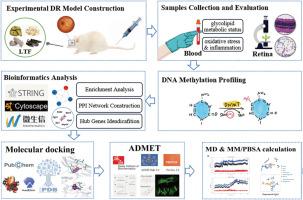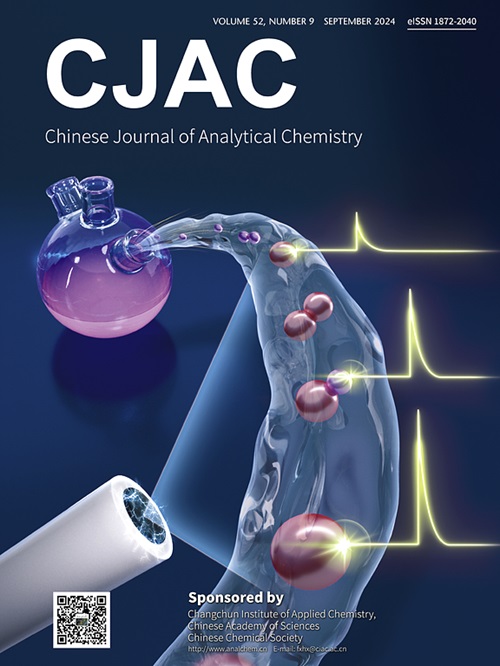Traditional Chinese medicine Luo Tong Formula attenuates retinal injury in experimental diabetic retinopathy via modulation of DNA methylation: In vivo experiment integrated with molecular docking, ADMET assessment, and molecular dynamics simulation
IF 1.3
4区 化学
Q4 CHEMISTRY, ANALYTICAL
引用次数: 0
Abstract
Background
Diabetic retinopathy (DR) is a leading cause of blindness in the adult population. Luo-Tong formula (LTF), a traditional Chinese medicine prescription, has been frequently employed in the treatment of DR. However, the ability of LTF to prevent retinal injury and disease progression, as well as potential mechanisms, remain unknown.
Objectives
To investigate the effect of LTF in alleviating DR and uncover the potential hub targets.
Methods
An experimental DR model was established to assess the effect of LTF and elucidate its underlying mechanism. Retinal thickness, morphological changes of retinal microvessels, as well as the numbers of endothelial cells and pericyte ghosts, were examined. Methylation status was evaluated with methylated DNA immunoprecipitation processing. Bioinformatic analysis of array results was used to screen hub genes. Interactions between potential targets and active compounds were assessed by molecular docking. ADMET analysis was used to evaluate drug-likeness characteristics and toxicity. Molecular dynamics (MD) simulation and MMGBSA calculation of binding free energies were conducted for the optimal core active compound-target complexes obtained by molecular docking.
Results
The administration of LTF demonstrated improvements in glycolipid metabolic disorder and a significant reduction in oxidative stress and inflammation in DR rats. Additionally, LTF exhibited protective properties against retinal injury. A quantitative analysis of DNA methylation indicated alterations in the composition and quantity of methylated genes following LTF intervention. Four important functional epigenetic modules and six hub genes (Fgfr1, TOX3, Rps9, Rps15, Rpl7, Mrpl36) were identified. Molecular docking identified ten compounds of LTF and 23 binding complexes with lower binding energy (< 7 kcal/mol), while five compounds were excluded after ADMET analysis. Two complexes (Aloe-emodin-TOX3, Panaxatriol-Fgfr1) with the lowest binding energy were further chosen for MD simulation and both complexes have stable and satisfactory binding systems. Finally, MMGBSA calculation of binding free energies revealed that Panaxatriol-Fgfr1 complex was identified as the drug-target candidate in the pharmacological treatment of DR.
Conclusions
LTF has demonstrated efficacy for DR, and its mechanisms may be associated with the regulation of DNA methylation. Panaxatriol-Fgfr1 complex was identified as the drug-target candidate. Epigenetic modifications following LTF intervention have been implicated in the pathogenesis of DR and offer potential therapeutic opportunities for early diagnosis and treatment in the future.

中药络通方通过调节DNA甲基化减轻实验性糖尿病视网膜病变视网膜损伤:结合分子对接、ADMET评估和分子动力学模拟的体内实验
背景:糖尿病视网膜病变(DR)是导致成人失明的主要原因。络通方(LTF)是一种常用的治疗dr的中药方剂,但其预防视网膜损伤和疾病进展的能力及其可能的机制尚不清楚。目的探讨LTF在缓解DR中的作用,揭示潜在的中枢靶点。方法建立实验DR模型,评价LTF的作用并阐明其作用机制。观察视网膜厚度、微血管形态变化、内皮细胞和周细胞鬼影的数量。甲基化状态用甲基化DNA免疫沉淀处理评估。对阵列结果进行生物信息学分析,筛选枢纽基因。通过分子对接评估潜在靶点与活性化合物之间的相互作用。采用ADMET分析评价药物相似特性和毒性。对通过分子对接得到的最优核心活性化合物-靶标配合物进行了分子动力学模拟和结合自由能的MMGBSA计算。结果LTF可改善DR大鼠的糖脂代谢紊乱,显著降低氧化应激和炎症。此外,LTF对视网膜损伤具有保护作用。DNA甲基化的定量分析表明,LTF干预后甲基化基因的组成和数量发生了变化。鉴定出4个重要的功能表观遗传模块和6个枢纽基因(Fgfr1、TOX3、Rps9、Rps15、Rpl7、Mrpl36)。分子对接鉴定出10个LTF化合物和23个结合能较低(< 7 kcal/mol)的结合物,ADMET分析排除了5个化合物。进一步选择结合能最低的两个配合物(芦荟-大黄素- tox3, Panaxatriol-Fgfr1)进行MD模拟,这两个配合物都具有稳定且令人满意的结合体系。最后,MMGBSA结合自由能计算结果显示,Panaxatriol-Fgfr1复合物被确定为DR药理学治疗的候选药物靶点。结论sltf对DR具有一定的疗效,其作用机制可能与调节DNA甲基化有关。Panaxatriol-Fgfr1复合物被确定为候选药物靶点。LTF干预后的表观遗传修饰与DR的发病机制有关,并为未来的早期诊断和治疗提供了潜在的治疗机会。
本文章由计算机程序翻译,如有差异,请以英文原文为准。
求助全文
约1分钟内获得全文
求助全文
来源期刊
CiteScore
3.60
自引率
25.00%
发文量
17223
审稿时长
35 days
期刊介绍:
Chinese Journal of Analytical Chemistry(CJAC) is an academic journal of analytical chemistry established in 1972 and sponsored by the Chinese Chemical Society and Changchun Institute of Applied Chemistry, Chinese Academy of Sciences. Its objectives are to report the original scientific research achievements and review the recent development of analytical chemistry in all areas. The journal sets up 5 columns including Research Papers, Research Notes, Experimental Technique and Instrument, Review and Progress and Summary Accounts. The journal published monthly in Chinese language. A detailed abstract, keywords and the titles of figures and tables are provided in English, except column of Summary Accounts. Prof. Wang Erkang, an outstanding analytical chemist, academician of Chinese Academy of Sciences & Third World Academy of Sciences, holds the post of the Editor-in-chief.

 求助内容:
求助内容: 应助结果提醒方式:
应助结果提醒方式:


